Current events are not typically something that Forgotten Weapons is going to comment on, but the recent unpleasantness in France has brought to light a firearm that folks may find interesting – the Mousqueton AMD.
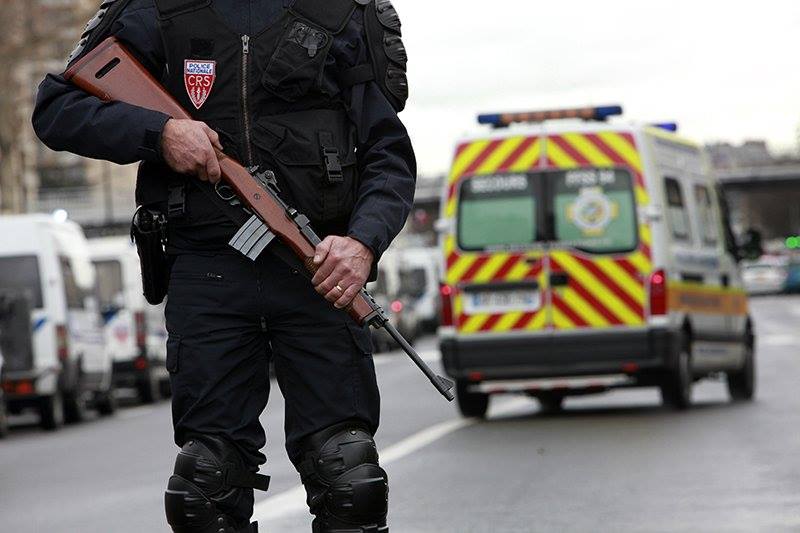
When French national police and security forces decided to replace the MAT-49 submachine gun as a standard weapon, they decided to look for a light carbine. Something less obviously military than the FAMAS was desired, and the natural choice was the Ruger Mini-14, whose slightly civilian appearance is often considered to be one of its primary strengths. Ruger licensed the design to the French, who have assembled them in-country with a few changes from the normal production model we are used to seeing here in the US.
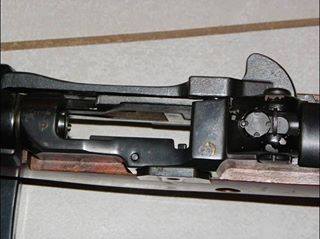
The guns come with rubber buttpads and sling cutouts in the stock, as well as a slightly modified style of charging handle. They remain chambered for the 5.56mm NATO cartridge (which as a military caliber is requires a license for civilian use in France). The fire control system has a selector to allow semiauto, 3-round burst, and full-auto fire, and the receiver heel is marked specifically for the French:
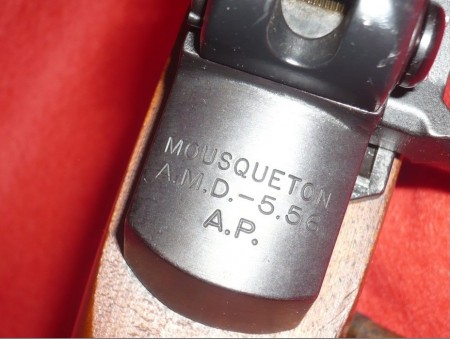
“Mousqueton” is of course the French term for carbine, and the “A.M.D.” stands for Armements et Moyens de Défense which translates roughly to “defensive arms”. The “A.P.” is a property marking for the Administration Pénitentiaire, or Prison Service.
All in all, a good choice of weapon for the purpose. I don’t have any information on how they have performed in practice for French security forces, but I expect they have done the job just fine.


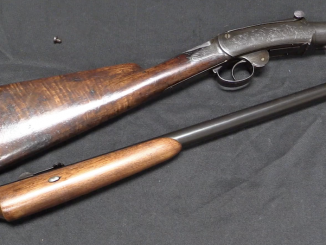
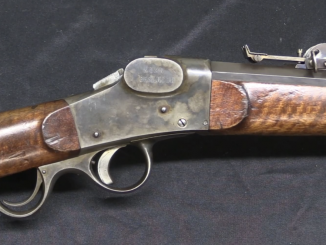
Great post, as always 🙂
How about a follow up on those Manurhin revolvers the GIGN guys use? That would be swell to know more about too 🙂
The M 73 revolver is like a Rolls Royce. It is a beautiful well make weapon that is very accurate. Just do not break it ; there are no” mere humans” who can fix them for less than a weeks pay.
Excellent choice of long arm for cops, I must say. At least this time France picked a good option rather than something overly complicated. Nice front sight too, almost sport-like…
Since police don’t get bayonets, I assume the way to deal with a knife-swinging attacker with no round in the carbine’s chamber is to whack the knife man with the stock. What type of wood is used in that Ruger, walnut?
The knife-wielder gets 5.56 in the center of mass until he stops coming.
There is no kill like overkill. Would a Hispano-Suiza flak gun deter knife-wielders?
* Carabine(in french) = carbine : short rifle (for military) & rifle in civil terme.
* Mousqueton (in French) => Short Rifle (like carabine/carbine.
In fact, you coule have the same weapon with 2 names in function of the units & traditions
Does this distinctions have something in common with the ammo used? I know that in several European countries the categorisation of the firearms is based on the ammunition used, so rifle’ (or equivalent) denotes only the weapons using full-sized rifle cartridge (e.g. 7.62×51 NATO) and ‘carbine’ is reserved for weapons using intermediary cartridge, like a British ‘battle rifle’ vs. ‘assault rifle’ distinction. Do you know, perchance, if such terminology is also used in France? This would be interesting.
Hi Wereboar,
In France we call carbine any rifled civil long firearm (for hunting or sport shooting) and also any shortened version of a military regular rifle.
A mousqueton is a shorter version of a military carbine (see Berthier or Gras systems)
We call rifle any hunting smoothbore long firearm, and any military regular rifled long firearm excepted machine guns(fusils mitrailleurs/mitrailleuses), and submachine guns(pistolets mitrailleurs).
In those cases distinctions are not related with the used ammunitions.
Cool! If one falls out of the sky and hits me on the head, at least I will know what it is.
I knew that Ruger and France had a connection, Ruger revolver frames being used in France in the early days of France’s use of the .357 Magnum.
I have a Mini-14, and while it is not the best rifle out there, it would serve quite well for the purposes that the French are using it.
There is no ‘best rifle’. Like anything that is engineered, a little change in the criteria and the ‘best rifle’ becomes 2nd rate.
I’ve had Mini-14’s since I was teen. I do have rifles that are better, but the Mini is still my go-to rifle. Just seems the 1st round always hits what I want to hit.
Ruger actually improved the design of the Mini-14 in 2006, the civilian market model had a thin and flimsy barrel, known for whipping and for opening up groups after some shooting.
In the 580 series Mini-14 rifles, they gave it a tougher barrel (which takes much more heat and doesn’t whip anymore), as well as redid the gas-system. I think they also replaced their tooling.
Though of course, for old Mini-14 rifles, there were barrel struts (Accu-Strut is one), which would stop the barrel from flexing and whipping when shot, which actually did quite a lot for the accuracy of the rifle.
It would be nice to have a view of the ‘slightly modified charging handle’…And who makes that 20rd magazine???
Realized I had a photo of the charging handle that didn’t get in, so I’ve added it.
Ruger makes a 20rd magazine, but maybe they are made in France too.
If you have a mini, use the Ruger-made magazines, all the other ones are mostly garbage. They won’t feed or if they do they won’t lock the bolt open on empty. Shot with one after-market magazine once and the floor plate flew off.
5,56 and other “weapons of war” ammo is not forbidden, but you need a permit for it. I am Dutch and only speak “holiday French”, but if I understand their laws correctly there are 5 categories of weapons beside hunting weapons. 4 of the 5 are permit categories and only hunting weapons and antiques are free. Still if you are a sport shooter you can obtain large calibre ammo like 9 mm, 5,56 or 7,62×39.
Thanks – I’ve corrected the post.
From what I have read, the “military calibre” restrictions in a number of European countries originated from the policy of universal military service. In order to be able to mobilize quickly in an emergency, the armouries, often poorly guarded, were scattered about the country where conscripts could go to pick up their weapons.
These armouries were often the targets of terrorists who would rob them to get arms. By limiting the availability of military calibres, it made getting further ammunition for stolen military arms more difficult.
This is less of a concern now though, since most European armies have dropped universal military service and reverted to all-professional armies.
There were certain calibres created simply to get around these restrictions. The 9x21mm IMI is one that I can think of. The ballistics are identical to the more common 9x19mm, but the extra 2mm makes it legally a different cartridge. It does mean though that a manufacturer can produce a firearm in both calibres with only minor modifications.
IIRC, the French law came about because the French government wanted all their guns back that the resistance took during the war. The Wiemar Republic did the same thing.
I’ve also heard that this law was either about to end, has ended or was in the talks of removing it.
“the French law came about because the French government wanted all their guns back that the resistance took during the war.”
The French “no-military cartridge” law was done in April 18, 1939. It was aftermath of Hitler’s actions in Europe. Apparently French government fear their citizens more than German Forces. It was later useful to legally collect Resistance weapons, but didn’t made especially to solve this problem.
My guess is that they looked at what the SA stormtroopers had done during the Nazi rise to power and were fearful of the same thing happening in France. And thought that despite Weimer-era gun control laws utterly failing in Germany, somehow similar laws would be all that was needed in France.
Every now and then, you might run into a postwar (aluminum-frame) commercial Walther P.38 in 7.65mm Parabellum aka .30 Luger. While they were available here in the States for anyone who waned to order one, the main market for .30 was countries like Italy, which had similar restrictions on civilian use of military caliber arms. I believe SiG also did a similar “trick” with some of their service autos, notably the P-210.
As Michel Josserand and Jan Stevenson noted in Pistols, Revolvers, and Ammunition(1970), the potential of the “.30s” with high-velocity hollowpoints should have been pretty obvious.
cheers
eon
SIG did 7.65 Para barrels for the P210 because 7.65 Para was the previous Swiss service cartridge and thus available, and the inherent accuracy and high precision is very much in demand for the Swiss shooting programme. Indeed, in the Ordonnanz-category at the various big matches, the P210 in 7.65 Para dominates.
“There were certain calibres created simply to get around these restrictions. The 9x21mm IMI is one that I can think of.”
The law-powered popularity of cartridges is interesting and broad topic. For example .38 Super is viable option if you want 1911 automatic pistol but law in your country prohibit use of military cartridge (IIRC this lead to popularity of .38 Super in Mexico).
There was not such law (i.e. “ban all military cartridges”) in United States, the popularity of cartridges depends (beside from technical factors) on shooting competition rules – for example it leads to 16-gauge falling into oblivion and 20-gauge still being popular.
The 5.56×45 NATO is not banned for civilian use, it’s just submitted to licence.
While the French AMDs certainly are a unique Mini 14 design they are certainly Rugers. There is even a Ruger rollmark on the left side of the receivers. I’ve also counted at least 4 different variations of this rifle. Some have the old style wood op rod covers and some plastic. Some have full auto selectors and some are semi-auto. Some have regular rear sights and some have a rear sight in front of the receiver.
Link to a pic of them without rear sights on the back.
they’ve got an open sight protected by the funny woodwork. Apparently it’s to remove any sharp bits (hence the modified cocking handle too) to stop them ripping chunks out of various swampies when doing crowd control, pushing them back with the rifle.
Didn’t Jim Sullivan design the Mini 14? I always kind of like the Mini.
Yes, he did.
The former Royal Ulster Constabulary (now The Police Service of Northern Ireland)choose the Mini-14 for the same reason: Military type performace without looking too “military”.
Kind of a bizarre reason to choose a weapon, if you ask me, but that seemed to be a theme with a lot of similar organizations back in the 1980’s especially. A lot of the SWAT-type teams here in Canada used them around the same time as well and though I am not sure if it was for the same reason, it is possible. Though, in the case of the Canadian SWAT teams it is also worth considering that in the 1980’s and into the 1990’s the Mini was viewed as the ‘poor man’s AR-15’ as the only AR game in town was Colt, and they cost at least a few hundred dollars more than a Mini. That could possibly influence decisions as well, when you consider that they’re equally reliable and both will do the job of a Police Rifle about equally well.
I have a picture somewhere of Montreal ERT guys with Mini-14’s and a few Colt SP1’s responding to the Ecole Polytechnique shooting, which was done with a Mini-14.
Anyway, I personally quite like the rifle. I have zero interest in the M-14 but the Mini has always held a special place in my heart, mostly because of a severe case of 1980’s nostalgia I have going on. A Mini is on my list of guns to buy in the near future.
Cheers.
In the US back in that era (late 70’s and 1980’s) the Min-14 was very popular with law-enforcement. “The Tactical Edge” by Charles Remsberg described the state-of-the-art police tactics as of 1986 (although a lot of it is still current) and the author took a lot of photos of SWAT teams such. Going off memory (loaned the book to a Sheriff’s Deputy a year ago and never got it back) the Mini-14 was the predominant rifle that showed up; policemen with AR-15 were probably tied with the Styer AUG. In a Guns Law-Enforcement Annual from 1980, LA SWAT was using AR-180’s. The point being that before the AR’s took over there was a pretty good mix of carbines used by domestic law enforcement.
Part of the reason of why the Mini was so popular then sort of fell out of favor could be that when the Mini hit the scene the senior law enforcement officers in each area were veterans of WWII and Korea. The Mini was their kind of rifle. Later on, the Vietnam vets took over as the WWII and Korean war era leaders retired, and the Vietnam vets were more familiar with the AR.
For typical police use, I’m not sure that a Mini with a rail for the top handguard is any worse than an AR. With good magazines I’d rate the Mini as being more reliable. For military use I don’t think the Mini would be as maintainable in the long run, but in police use that would be a non-issue. One advantage of a Mini is that it can have a proper folding stock so it can make for a compact package (which would be especially advantageous for plain clothes law enforcement officers — if the FBI in Miami had had folding stock Mini’s in the front seats of their units, the 1986 shoot out would have been over in a few seconds). The Mini is also naturally ambidextrous. I think it got a bad rap as Ruger did not sell high-cap magazines until after Bill Ruger died, which meant that hardly anyone had good magazines and the accuracy was pretty poor compared to an AR, but not an issue for the across-the-street distances that would be typical in police shoot outs. And as others have said, the Mini cost less than what Colt was selling AR’s for in those days.
Another point, that others have pointed out, was if you look at the uniforms of the time, in the Mini-14 era cops wore ties, traditional police hats, and Oxford shoes. In the AR era they wear ball caps, fatigues, and combat books. The guns they have / had go with the image they are/were projecting.
I understand from some former RIC constables that there were two other reasons for choosing the Mini-14. One was that they had previously been using WWII surplus US M1 Carbines, which were getting worn out and needed replacing. The Mini-14 was something they could replace them with without excessive retraining since the general layout and handling of the rifle would have been similar (i.e “traditional” stock).
The other reason was that they were considered to be more “plod” (police constable) proof than for example a typical modern military rifle. The stock was very robust and would survive being banged into doors or someone’s skull a few times, while a lot of modern military rifles tend to be more fragile in that sense.
The above, together with the “not military looking” aspect were reasons why this rifle was very popular among a number of police forces.
There were a number of other “police carbines” by the way which used pistol ammunition. Police may on occasion need more range and accuracy than a pistol, but they rarely need anything like the range, accuracy, or power of a military arm.
In the above, I meant RUC, not RIC.
So is the changeover from the M1 Carbine the reason for the slot in the stock? I assume that’s for a sling. Is there an oiler in the slot?
BTW, I have both a Min-14 and an M1 Carbine. Love ’em both, but the Carbine is a lot more fun for casual plinking at the range. (I reload both cartridges.)
Prior familiarity with the .30 M1 Carbine may have influenced the French police as well. The M1 Carbine was very common with them in the early postwar era, as many police officers who had been Resistance or FF soldiers had used it during the war. Also, its relatively low-velocity (by rifle standards), pistol-type bullet gave a good balance of accuracy, hitting power, and lack of overpenetration for “in-town” use.
Similar considerations, plus the simple fact that they could be had from military stores, caused the MAS38 7.65 Long SMG to gain a new lease on life as police armament for a decade or so after VE-Day. Again, it was considered powerful enough for the job, but less likely to be “too much”. This was of course at a time when the usual standard police sidearm in France was a 7.65mm Browning caliber automatic, as it was in most of the rest of Western Europe.
Frankly, I’ve always thought the Mini-14 hit the “sweet spot” of defensive/utility rifles. Powerful enough for most jobs not requiring shooting at medium-to-large wildlife, capable of reasonable firepower, but relatively “innocuous” looking.
My one objection was the peep sight. Some of us who wear glasses have always done better work with a rear sight “out on the barrel”, as on the SKS. Or for that matter, the old ’94 Winchester.
cheers
eon
Rear sight made this way are probably more coherent with the concept of a weapon that can be used in a riot without harmful protuding parts that would hurt more than necessary when melee strikes are required (or accidental contact with any part of the body).
They also used Ruger revolvers at time, maybe they got a good price for the pair.
Very insightful article about gun ownership in France:
http://www.thebangswitch.com/its-not-about-safety-its-about-control-and-confiscation/
I’m amazed to see some form of law enforcement using Mini-14s, almost everyone now uses an AR-15. Anyone else think the cut in the butt stock makes it resemble an M1 Carbine?
I think the French military once fell in love with M1 Carbines, as they used them extensively in Vietnam.
They’re pretty damn nice little rifles.
Shame .30 Carbine is so obscure these days, it’s a very nice light rifle cartridge, I’d love a nice and SBR’d little AR-15 using 30rd mags.
Does anyone know what is rifling pitch on this gun? Is it for original 5.56 light (M193) hi-velocity bullet? Although it is agreeable that this is nearly optimum tool for serious policing, one would also tend to think of ‘less lethal’ .30 Carbine.
I wonder what the swat troops involved in last week Friday siege of kosher supermarket carried. Same gun? I can see there are some genuine Frenchmen among us,,,,,
I believe that the RUC used the Mini 14, in the automatic variant. Not sure if the PSNI (the successor organisation) still uses them.
I was surprised to see a photo of a French cop with a Beretta M12, not something I would normally associate with France.
Police forces use Beretta M12 (assemblied by M.A.S.) meanwhile Gendarmerie forces (linked to Army) use MP5.
In the 1970s and 80s the police used MAS 36 and 36/51 rifles , US M1 carbines (much loved by their users) and rarely sub machineguns. The use of long arms was a show of force more than an intent to fire on civilians. The MAS 36/51s were used to launch gas grenades and flash bang type projectiles. One would sometimes see HKMP 5s in the hands of special operations groups. MAS/MAT 38 (for which there was almost no ammo) and 49s which are too damn heavy were in the supply chain but rarely issued,
.
Incidentally, the last Suomi SMGs still in official Finnish service are for the so called “reserve police”, which can only be activated in situations of major national emergency. The “support weapon”, as it is officially called, of the regular Finnish police since year 2000 is the MP5. Before that Suomi SMGs could have been used by the regular police as well, although in practice one never saw them. Thankfully the Rapid Response Unit (which is the only real SWAT unit in Finland) had more modern weapons.
Hah, can you imagine some guy in full battle rattle and a gasmask, hauling that heavy old piece with him when making an entry?
It’d certainly make for a very robust club, at the very least, and with the hefty weight recoil must be nonexistent.
Note that the top picture is a select-fire Mini-14, you can see the selector behind the rearsight on the right-hand side of the receiver.
I was watching the live footage on friday, and I counted at least 3 variants of Mini 14’s, HK 416, HK 417, Sig SG 55x, MP5’s, those funny Beretta SMG’s, Accuracy Internationals.
By the way, the French distinction between military and non-military calibres in the licensing system dates from 2 world wars having been fought in france. Post war, there were a large number of captured and stolen military arms stashed in the “grenier” in case it happened again. The idea of Razzias shaking down every house in the country would have been a bit reminiscent of the occupation, so the solution was to make the ammunition harder to get hold of – only licensed sports shooters could get it. The distinction is now pretty much obsolete and has been watered down somewhat, with some calibres changing categories.
the MINI 14 was used by the BRI (brigade de recherche et d’intervention) for shooting the “famous” gangster jacques mesrine in 1979:
http://en.wikipedia.org/wiki/Jacques_Mesrine
http://www.wat.tv/video/extrait-film-mesrine-55v55_4vegh_.html
http://www.dailymotion.com/video/xcyhgz_la-mort-de-jacques-mesrine-le-2-nov_news
http://www.dailymotion.com/video/x8i8zi_jacques-mesrine-antenne-2-jt-20h-2_news
“5,56 and other “weapons of war” ammo is not forbidden, but you need a permit for it. I am Dutch and only speak “holiday French”, but if I understand their laws correctly there are 5 categories of weapons beside hunting weapons. 4 of the 5 are permit categories and only hunting weapons and antiques are free. Still if you are a sport shooter you can obtain large calibre ammo like 9 mm, 5,56 or 7,62×39.”
hunting weapons need a hunting license, and they are registreds.
full auto are banned for civilians. (rares exceptions …)
_ military weapons (semi auto pistols, ar15, ak, ect) require authorization
_ pistols (even single shoot, revolvers, semi auto carbines… require authorization
_ classic shoot guns, semi auto shootguns limiteds to 3 shoots, and manual repartition carbines limited to 11 shoots. registred. require hunting license or sport license.
_ air rifle >20 joules, deactivated weapons, and antiques before 1870: free.
M-1 Carbine…I saw a M-1 Carbine. 1st Assumed it was a Mini 14 but it didn’t have a gas block. Had wood.
* Carabine = carbine
* Mousqueton = musketoon
the mini 14 was used in 1979 by the BRI (brigade de recherche et d’intervention) for shoot the “famous” gangster Jacques Mesrine:
http://en.wikipedia.org/wiki/Jacques_Mesrine
http://www.ina.fr/video/DVC7908257301
the movie:
http://www.wat.tv/video/extrait-film-mesrine-55v55_4vegh_.html
This is ”reserve weapon” for SHTF situations to give more firepower to standard police officers (they only use sidearms and maybe sometimes shotguns) and anti-riot units, they also use Berreta model 12 smg.
IIRC they are slowly phased-out since mid 2000’s for HK ar-15 clones.
I noticed the weapon shown in the posthumous “promotion” video, on behalf of I.S apparently was a Vz58 SBR which have been sold in the U.S by a company called Czechpoint once marketed as “pistols” in the semi automatic configuration.
I assume it was stolen from a French licensed shooter, if they still have access to such weapons in France which reading the above I think they do.
I really admire the Mini-14, especially the less mundane militarized models like the GB and AC556 variants. Recently I acquired a new condition blued GB model from 1979 and although it’s super cool, I really have no desire to shoot it. It’s more of a fascination with the design and it fore bearers I think.
The AMD is not bad but it would have been better if they made a MAS-49 in 5.56 as the Mini 49. The cocking handle of the AMD looks good though.
Good Morning America
As a French weapons hobbyist, I was quite surprised to see the Mousqueton AMD in the hands of our Policemen. This weapon was said to be kept in reserves by the authortities, who gave the police forces other weapons more suitable for urban use (mostly 9 mm HK UMP, MP5 they already had since many years and short barreled AR-15 style 5,56 short rifles).
I think replacement of the AMD is taking quite a long time, as weapons replacement in France always do and this is why we can still see the weapon in the hands of the French police today. Or maybe is it the situation, which implied to arm a great number of policemen, that made the authority to pick those “old” Mini-14 from the reserve.
I had the chance to talk about this rifle with several policemen and they all agreed to say it was a quite accurate (in police shooting context), light and very manoeuvrable rifle that constituted a real and appreciable advantage in case of emergency (as were the events of the past week).
American weapons are very highly considered in France, even by our soldiers and policemen who are used to (and proud of, too) French weapons. French soldiers, who are aware of the great advantages and capabilities of the FAMAS, frequently point its great disadvantages, like it’s absolute need for prenium quality steel case ammunitions, its heavy weight and its quite complicated mechanism with many little pieces very easy to loose. The Mini-14, as well as being a reliable and good overall weapon, was reminiscent of the USM1 the French police used since WWII and until the 1990’s (and still kept in reserve storage !), which was an advantage during the training, as the shape and controls of the two weapons are similar. French policemen are very proud of it.
S.N.A.L. gave a good description of the French law on weapons. In fact, what he said concern the previous law, which is now replaced by the September 6th , 2013 law. Nevertheless, it is almost the same as the previous, just a little bit more tolerant on X, a little bit more severe on Y.
Interesting article. Thanks for posting it. FWIW I came to this article via a link in a post on The Firearms Blog. Also FWIW I believe, based on dim memories of a magazine about the arms of the French Police, that the weapons used in the shooting of hardcase gangster Jacques Mesrine were Mini-14s. Presumably Mousqueton AMDs.
Great article! I wasn’t aware that the French police had ever used Ruger Mini 14’s (AMDs) until I saw the videos on TV of the Charlie Hebdo incident. Being the proud owner of a Mini 14, I was sure that that was what I saw the police carrying. Anyway, I sent a link to your article to a friend who had vehemently argued that the French had not and would never use a Ruger firearm of any type! That settled the argument – he owes me a beer!
Thanks for the great article and the good information.
He owes you two beers, I’m pretty sure they’ve used Ruger revolvers.
The Miami Shootout actually DID have a Mini-14 present….but not with the FBI. It gave Platt and Matix the abilities of both suppression and penetration……https://en.wikipedia.org/wiki/1986_FBI_Miami_shootout……..
Prayers go out to France yet again…..
Just saw one on the news yesterday.
Couple good photos of French police with Mini-14s in today’s St. Denis action, here: http://news.sky.com/gallery/1589604/paris-police-raid-terror-hideout
I’m French in Paris and I appreciate your term “forgotten weapons”, weapons still in use by the police,but,I hope,changed by modern ones asap !